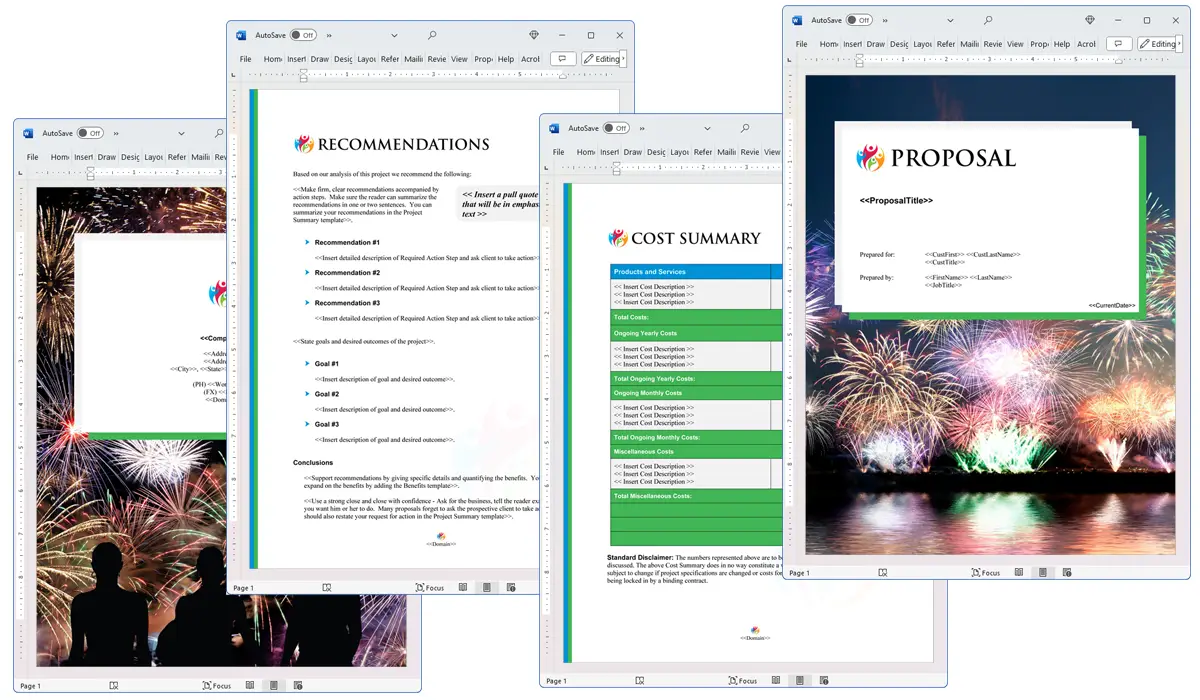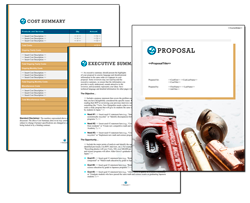What is the Reporting chapter used for?
Proposal Kit Professional Bundle adds more design themes, all six Contract Packs,
a project management library, and Expert Edition software.

Illustration of Proposal Pack Events #8
We include this Reporting chapter template in every Proposal Pack, along with thousands more. You assemble this chapter with others in various combinations to create custom-tailored business proposals, plans, reports, and other documents. Proposal Packs apply custom visual designs to the templates, giving the final documents a consistent professional finish.
 DOWNLOADABLE, ONE-TIME COST, NO SUBSCRIPTION FEES
DOWNLOADABLE, ONE-TIME COST, NO SUBSCRIPTION FEES
Overview of the Reporting Chapter
The Reporting chapter is a vital component in the structuring of a comprehensive business proposal. Its primary role is to outline the specific approaches toward reporting that will be adopted during the execution of a project or the operational phase of a contract. This chapter addresses several important aspects, including the frequency of reports, the responsible parties for report generation, and the format in which these reports should be presented. It helps in setting clear expectations and guidelines for monitoring and evaluating the progress and outcomes of business initiatives.
How is the Reporting Chapter Used?
In a business proposal, the Reporting chapter is used to communicate to potential clients or project stakeholders how information will be documented and shared throughout the course of the project. It provides a framework that assures stakeholders of transparency and accountability in project management. This chapter establishes trust by demonstrating a planned approach to keeping all parties informed and engaged through consistent and structured reporting.
What is Included in the Reporting Chapter?
Typically, the Reporting chapter includes:
- Types of Reports: This section outlines different reports that will be utilized, such as progress reports, financial reports, and compliance reports.
- Responsibility: It details who will be responsible for generating the reports. This could range from project managers to accounting personnel.
- Frequency: This specifies how often reports will be prepared and shared, whether weekly, monthly, or at project milestones.
- Format and Content: It describes the format in which reports will be delivered (e.g., PDF, printed document, online dashboard) and what information each report will contain.
- Distribution: Who will receive the reports, how they will be distributed, and the measures taken to ensure data security and confidentiality.
Use Case Examples for the Reporting Chapter
- In a proposal for a construction project, detailing monthly safety compliance reports to be submitted to regulatory authorities.
- For a marketing campaign, outlining weekly performance reports that analyze campaign metrics and adjustments.
- In a healthcare project, specifying the need for daily reports on patient care metrics to be shared with healthcare administration.
- In an IT project, stating the requirement for incident reports every time there is a cybersecurity threat detected.
- For a non-profit organization, detailing quarterly impact reports that are necessary for continued funding from donors.
Key Takeaways
- The Reporting chapter clearly defines how reports will be managed and shared in a business project.
- It ensures all parties are informed about the types, responsibilities, frequencies, and formats of reporting.
- Establishing a well-defined Reporting chapter in a proposal helps build trust and transparency with stakeholders.
- It plays an important role in project management by setting expectations for accountability and documentation.
- Tailoring the Reporting chapter according to the specific needs and standards of the industry or project enhances the effectiveness and relevance of the proposal.

Illustration of Proposal Pack Plumbing #2
 What Our Clients Say
What Our Clients SayThanks for all the help. I have installed both the programs on my laptop. I must congratulate the entire team for the efforts and putting such a generic solution covering all the possibilities in one wonderful pack. Great show and wish you and your team my very best."
Project Director,
R T C Pvt Ltd
 4.7 stars, based on 845 reviews
4.7 stars, based on 845 reviewsRelated Chapters
Samples Using the Reporting Chapter
Document Layouts Using the Reporting Chapter
- Extensive Service Sales Proposal
- Grant Proposal for Special Needs Support
- Domestic Violence Support Program Funding Proposal
- EMS Onsite Services Proposal
- Animal Farming Startup Proposal
- ERP (Enterprise Resource Planning) System Proposal
- Collections Agency Services Proposal
- Software Licensing Sales Proposal
- Food Aid Grant Project Proposal
- Banking Services Proposal
- Energy Efficiency Grant Project Proposal
- Assets Registry Report
- Accounting Proposal Template
- Project Management Consulting Services Proposal
- CCTV Inspection of Sewer Proposal
- Sanitary Transportation Food Safety Proposal
- Acquisition Plan Proposal
- Medical Billing Services Proposal
- Forensic Evidence Collection Services Proposal
- Mental Health Communication and Tracking App Proposal
- And more like these

The Reporting chapter and other chapters are integrated into a Word document as illustrated here in the Proposal Pack Transportation #6 design theme. There are hundreds of design themes available, and every design theme includes the Reporting chapter template.
A proper business proposal will include multiple chapters. This chapter is just one of many you can build into your proposal. We include the complete fill-in-the-blank template in our Proposal Pack template collections. We also include a library of sample proposals illustrating how companies in different industries, both large and small, have written proposals using our Proposal Packs. This template will show you how to write the Reporting.
We include a chapter library for you to build from based on your needs. All proposals are different and have different needs and goals. Pick the chapters from our collection and organize them as needed for your proposal.
Using the Proposal Pack template library, you can create any business proposal, report, study, plan, or document.
 Ian Lauder has been helping businesses write their proposals and contracts for two decades. Ian is the owner and founder of Proposal Kit, one of the original sources of business proposal and contract software products started in 1997.
Ian Lauder has been helping businesses write their proposals and contracts for two decades. Ian is the owner and founder of Proposal Kit, one of the original sources of business proposal and contract software products started in 1997.By Ian Lauder
 Published by Proposal Kit, Inc.
Published by Proposal Kit, Inc.


 Cart
Cart
 Facebook
Facebook YouTube
YouTube X
X Search Site
Search Site